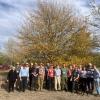Editor's Picks
Plant Focus
Richard S. Dodd and Prahlada Papper
Published May 2019 in International Oaks No. 30: 203–208
Abstract
The Red Oaks of California form a clade of four species that is distinct from Eastern North American Red Oaks. Of these four species, the Quercus wislizeni/Q. parvula complex has posed greatest confusion. We conducted a phylogenetic study of the clade, including a number of individuals of the two named varieties of Q. parvula from different localities. To improve phylogenetic signal, we removed individuals with a signal of recent admixture. The resulting maximum likelihood tree identified all four named species and both varieties as distinct clusters. However, the Purisima population of Q. parvula var. parvula appeared to be more related to the Palo Colorado population of Q. parvula var. shrevei than to its putative sister population on Santa Cruz Island. The population tree based on branch concordance factors from gene trees supported the same topology, but concordance factors were low for the Q. parvula clade, suggesting possible incomplete lineage sorting.
Keywords
Evolution, RADseq, phylogenetic networks, ancient hybridization, Quercus parvula var. shrevei, Quercus parvula var. parvula
References
Ané C., B. Larget, D.A. Baum, S.D. Smith, and A. Rokas. 2007. Bayesian Estimation of Concordance among Gene Trees. Moecular Biology and Evolutio, 24(2): 412-426.
Dodd, R.S., and Z. Afzal-Rafii. 2004. Selection and Dispersal in a Multispecies Oak Hybrid Zone. Evolution 58(2): 261-269.
Dodd, R.S. 2007. Range Expansion through Pollen Dispersal: Hybrid Studies in California Red Oaks. International Oaks 18: 42-50.
Durand, E.Y., N. Patterson, D. Reich, and M. Slatkin. 2011. Testing for Ancient Admixture between Closely Related Populations. Molecular Biology and Evolution 28(8): 2239-2252.
Garrison, E., and G. Marth. 2012. Haplotype-based variant detection from short-read sequencing. arXiv preprint arXiv:1207.3907.
Greene, E.L. 1887. New Species, Mainly Californian. Pittonia 1: 30-40.
Greene, E.L. 1889. lllustrations of West American Oaks From Drawings By the Late Albert Kellogg, M.D., text by Edward L. Greene. San Francisco, CA: Bosqui Engraving and Printing Co.
Hauser, D.A., A. Keuter, J.D. McVay, A.L. Hipp, and P.S. Manos. 2017. The evolution and diversification of the red oaks of the California Floristic Province (Quercus section Lobatae, series Agrifoliae). American Journal of Botany 104(10): 1581-1595.
Kashani, N., and R.S. Dodd. 2002. Genetic differentiation of two California red oak species, Quercus parvula var. shrevei and Q. wislizeni, based on AFLP genetic markers. USDA Forest Service General Technical Reports PSW-GTR-184. Albany, CA: USDA Forest Service, Pacific Southwest Forest Station.
Langmead, B., and S.L. Salzberg. 2012. Fast gapped-read alignment with Bowtie 2. Nat. Methods 9(4): 357-359.
Larget, B.R., S.K. Kotha, C.N. Dewey, and C. Ané. 2010. BUCKy: gene tree/species tree reconciliation with Bayesian concordance analysis. Bioinformatics 26(22): 2910-2911.
Li, H., B. Handsaker, A. Wysoker, T. Fennell, J. Ruan, N. Horner, G. Marth, G. Abecasis, and R. Durbin. 2009. The Sequence Alignment/Map format and SAMtools. Bioinformatics 25(16): 2078-2079.
Nixon, K.C. 1980. A systematic study of Quercus parvula Greene on Santa Cruz Island and mainland California. MS thesis, University of California, Santa Barbara, California, USA.
Nixon, K.C., and C.H. Muller. 1994. New Names in California Oaks. Novon 4: 391-393.
Peterson, B.K., J.N. Weber, E.H. Kay, H.S. Fisher, and H.E. Hoekstra. 2012. Double Digest RADseq: An Inexpensive Method for De Novo SNP Discovery and Genotyping in Model and Non-Model Species. PLoS ONE 7 (5): e37135.
Peterson, G.W., Y. Dong, C. Horbach, and Y-B. Fu. 2014. Genotyping-By-Sequencing for Plant Genetic Diversity Analysis: A Lab Guide for SNP Genotyping. Diversity 6(4): 665-80.
Pritchard, J.K., M. Stephens, and P. Donnelly. 2000. Inference of Population Structure Using Multilocus Genotype Data. Genetics 155(2): 945-959.
Ronquist, F., M. Teslenko, P. van der Mark P. Ayres D.L., Darling A.,Höhna S., Larget B., Liu L., Suchard M.A., and J.P Huelsenbeck. 2012. MrBayes 3.2: Efficient Bayesian Phylogenetic Inference and Model Choice Across a Large Model Space. Systematic Biology 61(3): 539-542.
Solís-Lemus, C., P. Bastide, and C. Ané. 2017. PhyloNetworks: A Package for Phylogenetic Networks. Molecular Biology and Evolution 34(12): 3292-3298.
Sork, V.L., S.T. Fitz-Gibbon, D. Puiu, M. Crepeau, P.F. Gugger, R. Sherman, K. Stevens, C.H. Langley, M. Pellegrini, and S.L. Salzberg. 2016. First Draft Assembly and Annotation of the Genome of a California Endemic Oak Quercus lobata Née (Fagaceae). G3: Genes, Genomes, Genetics 6(11): 3485-3495.
Stamatakis, A. 2014. RAxML version 8 : a tool for phylogenetic analysis and post-analysis of large phylogenies. Bioinformatics 30(9): 1312-1313.
Trelease, W. 1924. The American Oaks. Memoirs of the National Academy of Sciences 20: 1-255.
Wen, D., Y. Yu, and L. Nakhleh. 2016. Bayesian inference of reticulate phylogenies under the multispecies network coalescent. PLOS Genet. 12(5): e1006006.















